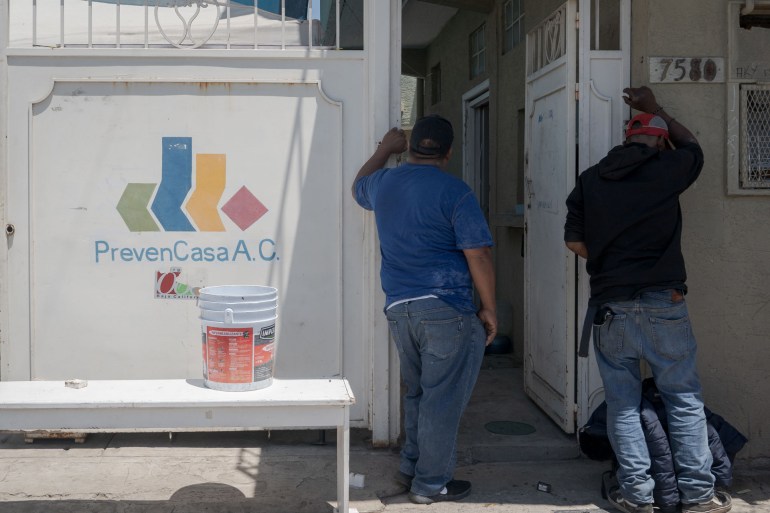Fentanyl plagues communities along US-Mexico border
Harm reduction groups say the synthetic opioid is often mixed into other drugs without the user’s knowledge.

Tijuana, Mexico – For Hugo Arroyo, a fentanyl user who works with the Tijuana-based harm reduction group Prevencasa, the drug has reached deep into his community.
“There was an epidemic. Everyone was overdosing,” Arroyo told Al Jazeera. “We were attending three or four [cases] per day.”
Keep reading
list of 3 itemsUS approves sale of overdose reversal drug without prescription
UN report says cocaine market booming as meth trafficking spreads
That was a couple of years ago, and at the time, many users were not even aware of what was hitting them, because the fentanyl was often mixed into other drugs without their knowledge. When Arroyo first tried it, he was told it was another substance.
“It leaves you completely anesthetised,” he said. Fentanyl, a synthetic opioid, is up to 50 times stronger than heroin, and Arroyo said people have died after using the same dose as they would for heroin or other substances.
Today, although overdoses appear to be down, fentanyl addiction continues to plague his community, while cross-border trafficking of the drug is a growing problem.

According to US Customs and Border Protection (CBP) data, during fiscal year 2023, fentanyl seizures at the southwestern border with Mexico have already exceeded 9,500kg (21,000 pounds) – a spike of about 50 percent more than the previous fiscal year. Approximately half was intercepted at the San Diego-Tijuana ports of entry.
“CBP has significantly increased non-intrusive inspection scanning capabilities and forward operating labs to swiftly identify suspected drugs and recognize trends,” the agency said in a statement earlier this month.
In the first half of 2023, the Mexican Red Cross responded to an average of nearly 70 overdoses a month in Tijuana, mostly involving men between the ages of 19 and 41, according to data provided by the organisation to Al Jazeera.
But it is not clear what drugs were involved; information about fentanyl overdoses in Mexico is scarce.
The Mexican Health Department reported only 19 deaths from opioids in 2021, although public health official Hugo Lopez-Gatell acknowledged during a media briefing this past April that “there might be some underreporting”. The government has not provided data on fentanyl for subsequent years.
Patterns emerging
In one case witnessed by Al Jazeera last month, a man fell unconscious in a main street of Playas de Tijuana, a mostly middle- and upper-middle-class neighbourhood of Tijuana. He went into respiratory arrest after using drugs, and the Mexican Red Cross provided emergency care.
They gave him Naloxone, a medication that reverses the effects of opioids, and the man began breathing again. Emergency workers told him fentanyl might have been mixed into the drug he consumed, although they did not have the tools to confirm.
In June 2022, the state forensic medical service in Baja California, where Tijuana is located, launched a study in the state capital, Mexicali, to assess whether the bodies they received contained fentanyl. The results were positive in 250 cases, nearly a quarter of the total.

In most cases, the bodies also tested positive for other drugs, mainly methamphetamine, which means the person was using both or it was mixed, Cesar Gonzalez, who heads the state forensic medical service, told Al Jazeera. Half of the total bodies analysed were positive for some type of drug.
The study was recently extended to Tijuana, and while Gonzalez said it was too early to share results, there appeared to be a “similar pattern to Mexicali”.
Meanwhile, Mexican President Andres Manuel Lopez Obrador contended during a news conference earlier this month that countrywide, “there is undoubtedly trafficking, but not drug use, or very little.”
Increased demand
Unlike in the US, where fentanyl demand spiked amid excessive prescriptions for opioid medications, activists and harm reduction workers say the drug gained traction in Mexico after traffickers allegedly began mixing it with other drugs to create addiction and spur demand.
“The number of people using illegal fentanyl has increased a lot. It gives you a more intense rush, but it lasts less than heroin, and that is more addictive,” Alejandro Gonzalez, a medical coordinator for Prevencasa, told Al Jazeera.

His group has observed a decrease in fatal overdoses amid more information about fentanyl and access to Naloxone, he added; this is a key focus of Prevencasa’s work, which includes workshops about the dangers of fentanyl, along with the distribution of drug tests.
Roberto Lopez, an artist and fentanyl user who lives on the street, told Al Jazeera that he used to spend more than 500 Mexican pesos ($30) a day on heroin.
Now, he spends between 50 and 100 pesos a day ($3-$6) on fentanyl, highlighting another reason for the drug’s increased demand: the cheaper price.
“I always carry a small bottle [of Naloxone] with me, wherever I go,” Lopez said, noting he has used it on many occasions to save other people’s lives, because “it can be someone’s son, someone’s brother, someone’s father”.